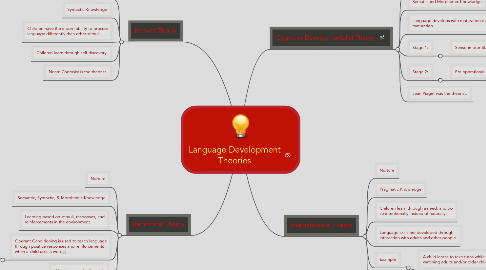Language Development Theories
作者:Renee Cox


1. Nativist Theory
1.1. Nature
1.2. Syntactic Knowledge
1.3. Children have the inborn ability to process language differently than other stimuli.
1.4. Children learn through self-discovery.
1.5. Noam Chomsky is the theorist.
2. Behaviorist Theory
2.1. Nurture
2.2. Semantic, Syntactic, & Morphemic Knowledge
2.3. Learning based on stimuli, responses, and reinforcements in the environment.
2.4. Operant Conditioning is used to teach language through positive responses and reinforcements when a child uses a word(s).
2.4.1. Example:
2.4.1.1. An infant makes sounds that sound like mama. Mom gets excited and cheers - baby keeps making that sound.
2.5. B.F. Skinner is the theorist.
3. Cognitive Developmentalist Theory
3.1. Nature
3.2. Sematic and Morphemic Knowledge
3.3. Language develops with maturation of cognitive maturation.
3.4. Stage 1:
3.4.1. Sensorimotor Stage (Prelinguistic)
3.4.1.1. Understanding through sensory and movement activities.
3.5. Stage 2:
3.5.1. Pre-operational Stage (ages 2-7)
3.5.1.1. Begins to understand language through words, images, and drawings.
3.6. Jean Piaget was the theorist.
4. Interactionalist Theory
4.1. Nurture
4.2. Pragmatic Knowledge
4.3. Children learn through a need, and do so intentionally instead of naturally.
4.4. Language skills are developed through interaction with adults and other people.
4.5. Example
4.5.1. A child learns to take turns while speaking by watching adults and/or older children do so
